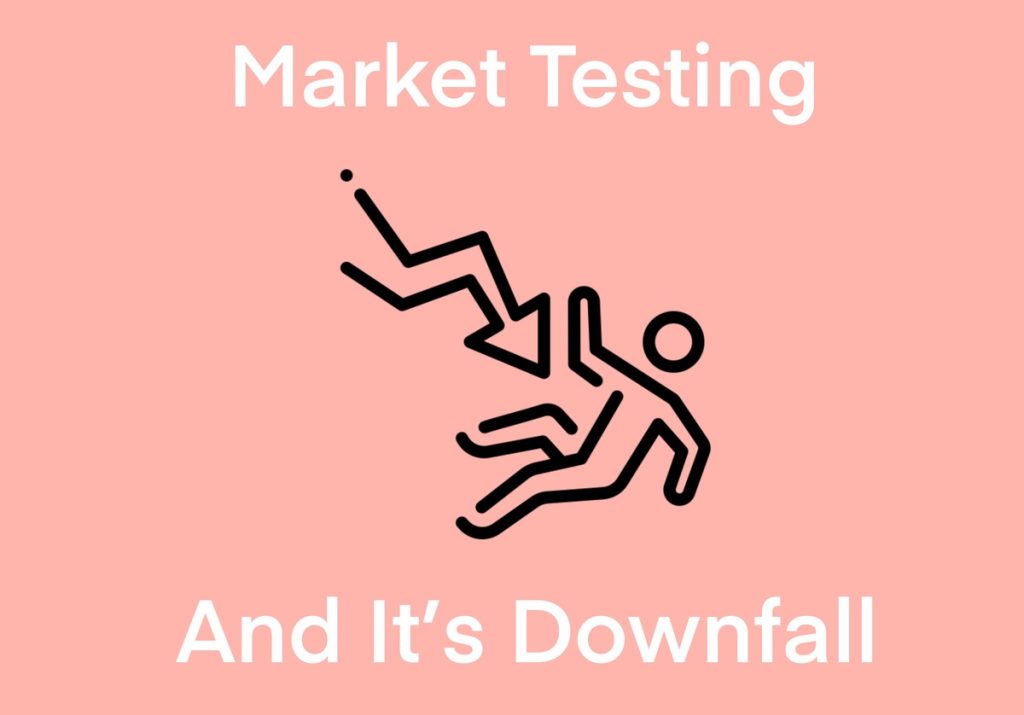A deep dive into market testing
Market Testing….and its Downfall
Business owners, content creators and designers often have an immense amount of conviction behind their ideas (I didn’t say “stubborn”, you did!). Occasionally, this “conviction” can create a severe disconnect between the “business side” and the side that matters most: CONSUMERS.
Market testing ‘softly’ gauges your target audience’s interest regarding your service or product before investing thousands of dollars (and hours) to create a full-blown strategy prematurely, which may fall flat on its face and make you look like a muppet in the process.

However, as beneficial as it may be, market testing can also have its setbacks so it’s important to identify when to and not to obtain feedback from your consumer-base.
Now, let’s review some of the most common forms of market testing and their effectiveness.
Common Types of Market Research
Questionnaires and Surveys
Pros
- Can gather large-scale feedback with minimal effort.
- Convenient form of quantitative research.
Cons
- Removes “emotion” out of the testing process thus less open-ended insights.
- Unless in a controlled environment, you have no idea exactly who is completing the questionnaire
- Respondent may rush through the questionnaire which reduces the quality of data retrieved.
Our Take: Unless you need (quantitative) feedback from hundreds and thousands of people, the convenience factor ain’t worth it because the insights won’t be very meaningful. Plus, apart from medical research, large scale feedback is rarely required.
Focus Groups
Pros
- Ability to gather individualized feedback, in a group-setting.
- Can detect “emotion” in real-time.
- Saves time by speaking to multiple people at once.
Cons – 3 words – “The Hawthorne Effect” aka altering your behavior due to being knowingly observed
- Telling the moderator what they want to hear
- Participants withholding opinions if they conflict with others in the group
- 1 or 2 people dominating the conversation leading to skewed results.
- Sometimes, even the moderator can unintentionally lend bias towards questions.
- Can be expensive if attendees are compensated for their time.
Our Take: Be tactful in the manner you arrange the focus group to mitigate The Hawthorne Effect (though it’s challenging to remove it entirely). Don’t let the participants know that you are watching, maybe even pretend to be a participant yourself (stealth mode).
Social Media
Social Media is the black sheep of this list as it’s not a common method of market testing but depending on the platform you use, there are benefits and drawbacks.
Pros
- Looking at your competitors on different platforms is a great way to identify what does AND DOES NOT work.
- Leveraging your FB page can also serve as a quick and easy way to get feedback from people who already follow your brand (and are therefore “pre-qualified”) – post a question/poll, then monitor engagement.
Cons
- Social media is an over-crowded marketplace
- While you may receive some insights, they likely won’t be meaningful to your business.
Our Take: Leverage social media to examine your competitors vs relying on it for consumer feedback. More importantly, identify what your competitors AREN’T doing so that you can fill that void.
In-Depth One-on-One Interviews
Pros
- One-on-One interviews – The holy grail of market testing – eliminate The Hawthorne Effect and allow the interviewer to obtain meaningful insights by unraveling the “why” behind someone’s thinking.
- If done correctly, they will enable the interviewer to detect trends and themes between the lines. This is not achievable in the aforementioned testing types.
Cons
- Requires more prep from the interviewer (identifying the goal, structuring the flow, creating Qs etc).
- Can require an immense amount of time to decipher through your notes, organize then analyze them (the value is worth the pain, if you ask me!).
Our Take: You may have guessed it…One-on-one interviews are not only my fav for conducting research, but something I use with all new clients to clearly understand their story. I listen intently for 90% of the time (you’d be surprised about the gems that will land on a platter if you just zip it) and then subsequently create the strategy stemming from their story.
Final Thoughts:
Remember, the “New Communication Model” (as Marty puts it) requires an ongoing dialogue with your customers. It doesn’t just stop after the questionnaire or focus group is completed. It’s an ongoing cycle.
- Testing can safeguard you from spending too much time and money on a strategy which lands flat upon hitting the market – be sure to test the group that’s most representative of your target audience persona
- Questionnaires and surveys are good for at-scale quantitative research
- If conducting a focus group, be sure to minimize The Hawthorne Effect
- Leverage social media for competitor analysis. Identify what they are NOT doing, and fill that void
- In-depth 1:1 interviews provide the best insights
- Always ask open-ended questions to understand the “why”
- Bigger is not always better when it comes to research, unless quantitative research is your goal (limited to few industries such as medical research)
- Lastly, don’t expect your ‘testing insights’ to lead to innovation (that’s your job!)







